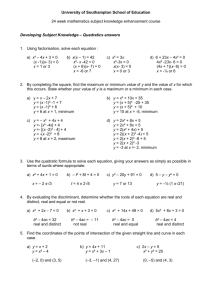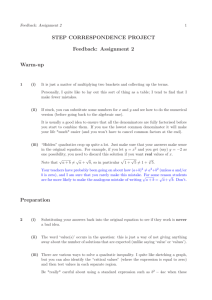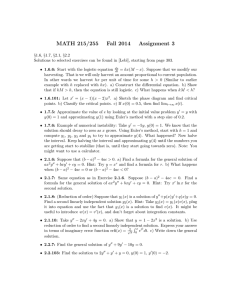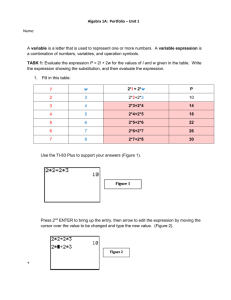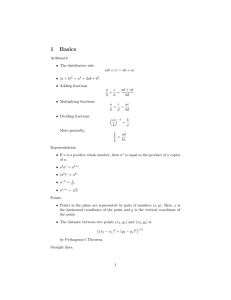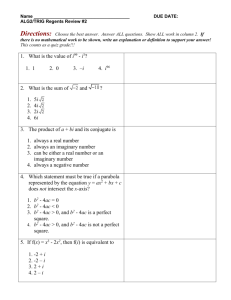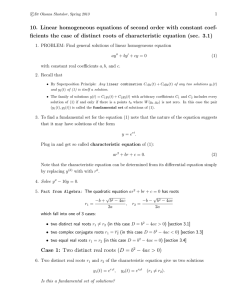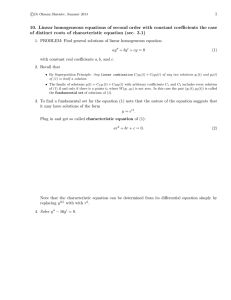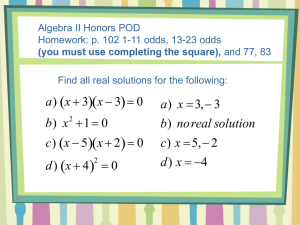LECTURE 11: MECHANICAL VIBRATIONS September 26, 2014
advertisement
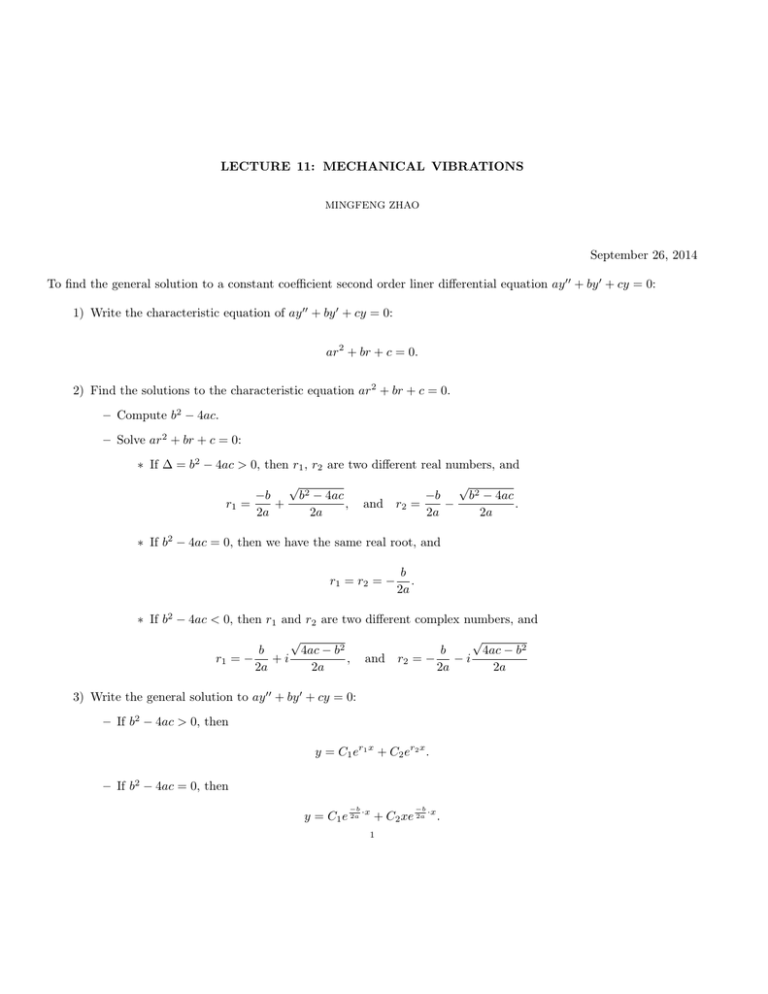
LECTURE 11: MECHANICAL VIBRATIONS MINGFENG ZHAO September 26, 2014 To find the general solution to a constant coefficient second order liner differential equation ay 00 + by 0 + cy = 0: 1) Write the characteristic equation of ay 00 + by 0 + cy = 0: ar2 + br + c = 0. 2) Find the solutions to the characteristic equation ar2 + br + c = 0. – Compute b2 − 4ac. – Solve ar2 + br + c = 0: ∗ If ∆ = b2 − 4ac > 0, then r1 , r2 are two different real numbers, and −b + r1 = 2a √ b2 − 4ac , 2a −b and r2 = − 2a √ b2 − 4ac . 2a ∗ If b2 − 4ac = 0, then we have the same real root, and r1 = r2 = − b . 2a ∗ If b2 − 4ac < 0, then r1 and r2 are two different complex numbers, and √ b 4ac − b2 r1 = − + i , 2a 2a √ b 4ac − b2 and r2 = − − i 2a 2a 3) Write the general solution to ay 00 + by 0 + cy = 0: – If b2 − 4ac > 0, then y = C1 er1 x + C2 er2 x . – If b2 − 4ac = 0, then −b −b y = C1 e 2a ·x + C2 xe 2a ·x . 1 2 MINGFENG ZHAO – If b2 − 4ac < 0, then √ y = C1 e b ·x − 2a cos 4ac − b2 x 2a √ ! b − 2a ·x + C2 e sin ! 4ac − b2 x . 2a Example 1. Find the general solution of 2y 00 + 50y 0 = 0. The characteristic equation of 2y 00 + 50y 0 = 0 is: 2r2 + 50r = 0. Solve 2r2 + 50r = 0, we get r1 = 0, and r2 = −25. So the general solution of 2y 00 + 50y 0 = 0 is: y(x) = C1 + C2 e−25x . Example 2. Find the general solution of y 00 = 0. The characteristic equation of y 00 = 0 is: r2 = 0. Solve r2 = 0, we get r1 = r2 = 0. So the general solution of y 00 = 0 is: y(x) = C1 + C2 x . Example 3. Find the general solution to y 00 + 2y 0 + 5y = 0. The characteristic equation of y 00 + 2y 0 + 5y = 0 is: r2 + 2r + 5 = 0. Solve r2 + 2r + 5 = 0, we get r1 = −2 + √ √ 4−4·5 −2 + −16 = = −1 + 2i, 2 2 and r2 = −1 − 2i. So the general solution of y 00 + 2y 0 + 5y = 0 is: y(x) = C1 e−x cos(2x) + C2 e−x sin(2x) . LECTURE 11: MECHANICAL VIBRATIONS 3 Mechanical vibrations Example 4 (Mass-Spring System). Suppose we have a mass m > 0 (in kilograms) connected by a spring with spring constant k > 0 (in Newtons per meter) to a fixed wall. There may be some external force F (t) (in Newtons) acting on the mass at time t (in seconds). Finally, there is some friction measure by c ≥ 0 (in Newton-sectons per meter) as the mass slides along the floor. Figure 1. Mass-Spring System Let x(t) be the displacement of the mass (x = 0 is the rest position, that is, the spring is neither compressed nor stretched), by Newton’s law, we have mx00 (t) = all forces acting on the mass. There are three kinds of forces acting on the mass: • External force: F (t) • Friction or Damping force: −cx0 (t) (negative means negative direction) • Spring Compression force: −kx(t) (negative means negative direction) So mx00 = F (t) − cx0 − kx, that is, mx00 + cx0 + kx = F (t) . Sometimes, we write it as: x00 + 2px0 + ω02 x = F (t) , m 4 MINGFENG ZHAO where c p= 2m r (dammping coefficient), ω0 = k m (frequency). Here are some terminology: I. The motion is forced if F (t) 6≡ 0. II. The motion is unforced/free if F (t) ≡ 0. III. The motion is damped if c > 0. IV. The motion is undamped if c = 0. Example 5 (RLC Circuit System). There is a resistor with a resistance of R ohms, an inductor with an inductance of L henries, and a capacitor with capacitance of C farads. There is also an electric source (such as a battery) giving a voltage of E(t) volts at time t (in seconds). Figure 2. RLC Circuit System Kirchhoff’s Voltage Law: The sum of the electrical potential differences (voltage) around any closed network is zero. Let Q(t) be the charge (in coulombs) on the capacitor, and I(t) be the current in the circuit, by Kirchhoff’s Voltage Law, we have Vresistor (t) + Vinductor (t) + Vcapacitor (t) = Vbattery (t). And • By Ohm’s Law: Vresistor (t) = RI(t). LECTURE 11: MECHANICAL VIBRATIONS 5 • By Faraday’s Law of Induction: Vinductor (t) = LI 0 (t). • By Capacitor equation: Vcapacitor (t) = Q(t) . C So we get Q(t) LI 0 (t) + RI(t) + = E(t). C Z On the other hand, we know that Q(t) = I(t), that is, Q0 (t) = I(t) So we have the following differential equation: LI 00 (t) + RI 0 (t) + 1 I(t) = E 0 (t) . C Department of Mathematics, The University of British Columbia, Room 121, 1984 Mathematics Road, Vancouver, B.C. Canada V6T 1Z2 E-mail address: mingfeng@math.ubc.ca
